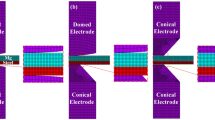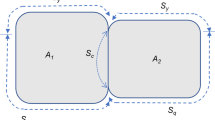Abstract
Copper electrodes are commonly employed in micro-resistance spot welding (MRSW), a dominant process used to join ultra-thin metallic sheets. During welding, some copper from the electrodes inevitably diffuses into the spot welds, changing the chemical compositions and properties of the resulting welded joints. In this study, 0.05-mm-thick Ti alloy metallic sheets were welded via MRSW under various combinations of welding parameters (ramping time, welding time, holding time, welding current, and electrode force). The effects of these welding parameters on electrode elemental diffusion were investigated via elemental analysis. Elemental composition of welded joints was measured via energy-dispersive spectrometry after tensile-shear tests. No copper was detected in the heat-affected zone or base material, but the amount of copper in the welding nuggets varied significantly with the welding parameters. Moreover, comparing copper element and hardness maps in weld nugget, the welding nugget hardness increased when more copper diffused into it.
Similar content being viewed by others
References
Chang B, Li M, Zhou Y (2001) Comparative study of small scale and ‘large scale’ resistance spot welding. Sci TechnolWeld Join 6(5):273–280
Wan X, Wang Y, Zhao D (2015) Multi-response optimization in small scale resistance spot welding of titanium alloy by principal component analysis and genetic algorithm. Int J Adv Manuf Technol 83(1–4):545–559. https://doi.org/10.1007/s00170-015-7545-9
Fukumoto S, Soeda A, Yokoyama Y, Minami M, Matsushima M, Fujimoto K (2013) Estimation of current path area during small scale resistance spot welding of bulk metallic glass to stainless steel. Sci Technol Weld Join 18(2):135–142
Wan X, Wang Y, Zhao D (2016) Multi-response optimization in small scale resistance spot welding of titanium alloy by principal component analysis and genetic algorithm. Int J Adv Manuf Technol 83(1–4):545–559
Wan X, Wang Y, Zhao D (2016) Quality evaluation in small-scale resistance spot welding by electrode voltage recognition. Sci Technol Weld Join 21(5):358–365
Mirzaei F, Ghorbani H, Kolahan F (2017) Numerical modeling and optimization of joint strength in resistance spot welding of galvanized steel sheets. Int J Adv Manuf Technol 92:3489. https://doi.org/10.1007/s00170-017-0407-x
Zhao D, Wang Y, Lin Z, Sheng S (2013) Quality monitoring research of small scale resistance spot welding based on voltage signal. ISIJ Int 53(2):240–244
Xing B, Xiao Y, Qin QH, Cui H (2017) Quality assessment of resistance spot welding process based on dynamic resistance signal and random forest based. Int J Adv Manuf Technol:1–13. https://doi.org/10.1007/s00170-017-0889-6
Vignesh K, Elaya Perumal A, Velmurugan P (2017) Optimization of resistance spot welding process parameters and microstructural examination for dissimilar welding of AISI 316L austenitic stainless steel and 2205 duplex stainless steel. Int J Adv Manuf Technol. https://doi.org/10.1007/s00170-017-0089-4
Jagadeesha T (2017) Experimental studies in weld nugget strength of resistance spot-welded 316L austenitic stainless steel sheet. Int J Adv Manuf Technol. https://doi.org/10.1007/s00170-017-0517-5
Safari M, Mostaan H, Yadegari Kh H, Asgari D (2017) Effects of process parameters on tensile-shear strength and failure mode of resistance spot welds of AISI 201 stainless steel. Int J Adv Manuf Technol 89(5):1853–1863. https://doi.org/10.1007/s00170-016-9222-z
Gauthier E, Carron D, Rogeon P, Pilvin P, Pouvreau C, Lety T, Primaux F (2014) Numerical modeling of electrode degradation during resistance spot welding using CuCrZr electrodes. J Mater Eng Perform 23(5):1593–1599. https://doi.org/10.1007/s11665-014-0908-9
Dong S, Zhou Y (2003) Effects of TiC composite coating on electrode degradation in microresistance welding of nickel-plated steel. Metall Mater Trans A 34(7):1501–1511
Peng J, Fukumoto S, Brown L, Zhou N (2004) Image analysis of electrode degradation in resistance spot welding of aluminium. Sci Technol Weld Join 9(4):331–336
Vural M, Akkus A (2004) On the resistance spot weldability of galvanized interstitial free steel sheets with austenitic stainless steel sheets. J Mater Process Technol 153:1–6
Karcı F, Kacar R, Gündüz S (2009) The effect of process parameter on the properties of spot welded cold deformed AISI304 grade austenitic stainless steel. J Mater Process Technol 209(8):4011–4019
Kianersi D, Mostafaei A, Amadeh AA (2014) Resistance spot welding joints of AISI 316L austenitic stainless steel sheets: phase transformations, mechanical properties and microstructure characterizations. Mater Des 61:251–263
Pereira A, Ferreira J, Loureiro A, Costa J, Bártolo P (2010) Effect of process parameters on the strength of resistance spot welds in 6082-T6 aluminium alloy. Mater Design 31(5):2454–2463
Penner P, Liu L, Gerlich A, Zhou Y, Penner P, Liu L, Gerlich A, Zhou Y (2014) Dissimilar resistance spot welding of aluminum to magnesium with Zn-coated steel interlayers. Weld J 93(6):225S–231S
Ghazanfari H, Naderi M (2013) Influence of welding parameters on microstructure and mechanical performance of resistance spot welded high strength steels. Acta Metall Sin-Engl 26(5):635–640
Metzbower E, Moon D (2007) Hardness changes on pass by pass basis in mild steel gas metal arc welds. Sci Technol Weld Join 12(2):189–196
Moon D, Lambrakos S, Wong R, Metzbower E (2003) Temperature, macrostructure and hardness in high strength low alloy steel welds. Sci Technol Weld Join 8(5):334–339
Standard test methods of tension testing of metallic foil (2013) ASTM International
Zhou K, Yao P (2017) Simulation of a uniform energy control strategy of single-phase AC resistance spot welding. Int J Adv Manuf Technol:1–9. https://doi.org/10.1007/s00170-017-0056-0
Athi N, Cullen J, Al-Jader M, Wylie S, Al-Shamma’a A, Shaw A, Hyde M (2009) Experimental and theoretical investigations to the effects of zinc coatings and splash on electrode cap wear. Meas 42(6):944–953
Kianersi D, Mostafaei A, Mohammadi J (2014) Effect of welding current and time on the microstructure, mechanical characterizations, and fracture studies of resistance spot welding joints of AISI 316L austenitic stainless steel. Metall Mater Trans A 45(10):4423–4442
Kaya Y, Kahraman N (2012) The effects of electrode force, welding current and welding time on the resistance spot weldability of pure titanium. Int J Adv Manuf Technol 60(1–4):127–134
Liu L, Zhou SQ, Tian YH, Feng JC, Jung JP, Zhou YN (2013) Effects of surface conditions on resistance spot welding of Mg alloy AZ31. Sci Technol Weld Join 14(4):356–361. https://doi.org/10.1179/136217108x394726
Massalski TB, Okamoto H, Subramanian P, Kacprzak L, Scott WW (1986) Binary alloy phase diagrams, vol 1. vol 2. American society for metals, Metals Park
Liu J, Li F, Liu C, Wang H, Ren B, Yang K, Zhang E (2014) Effect of Cu content on the antibacterial activity of titanium–copper sintered alloys. Mater Sci Eng C 35:392–400
Wang MG, Chen ZQ, Bao SJ, Zhou HQ (2011) Effect of Al, Sn and Cu on mechanical properties and Young’s modulus of titanium alloy. Dev Appl Mater 262(9):1775–1785
Acknowledgements
This work is supported by the Postgraduate Research & Practice Innovation Program of Jiangsu Province (KYCX17_0285) and the Innovation Base for Postgraduate and Open Foundation of the Nanjing University of Aeronautics and Astronautics (kfjj20160501).
Author information
Authors and Affiliations
Corresponding author
Rights and permissions
About this article
Cite this article
Chen, F., Gao, X.P., Yue, X.K. et al. Effects of welding parameters on electrode element diffusion during micro-resistance spot welding. Int J Adv Manuf Technol 95, 1597–1606 (2018). https://doi.org/10.1007/s00170-017-1240-y
Received:
Accepted:
Published:
Issue Date:
DOI: https://doi.org/10.1007/s00170-017-1240-y




